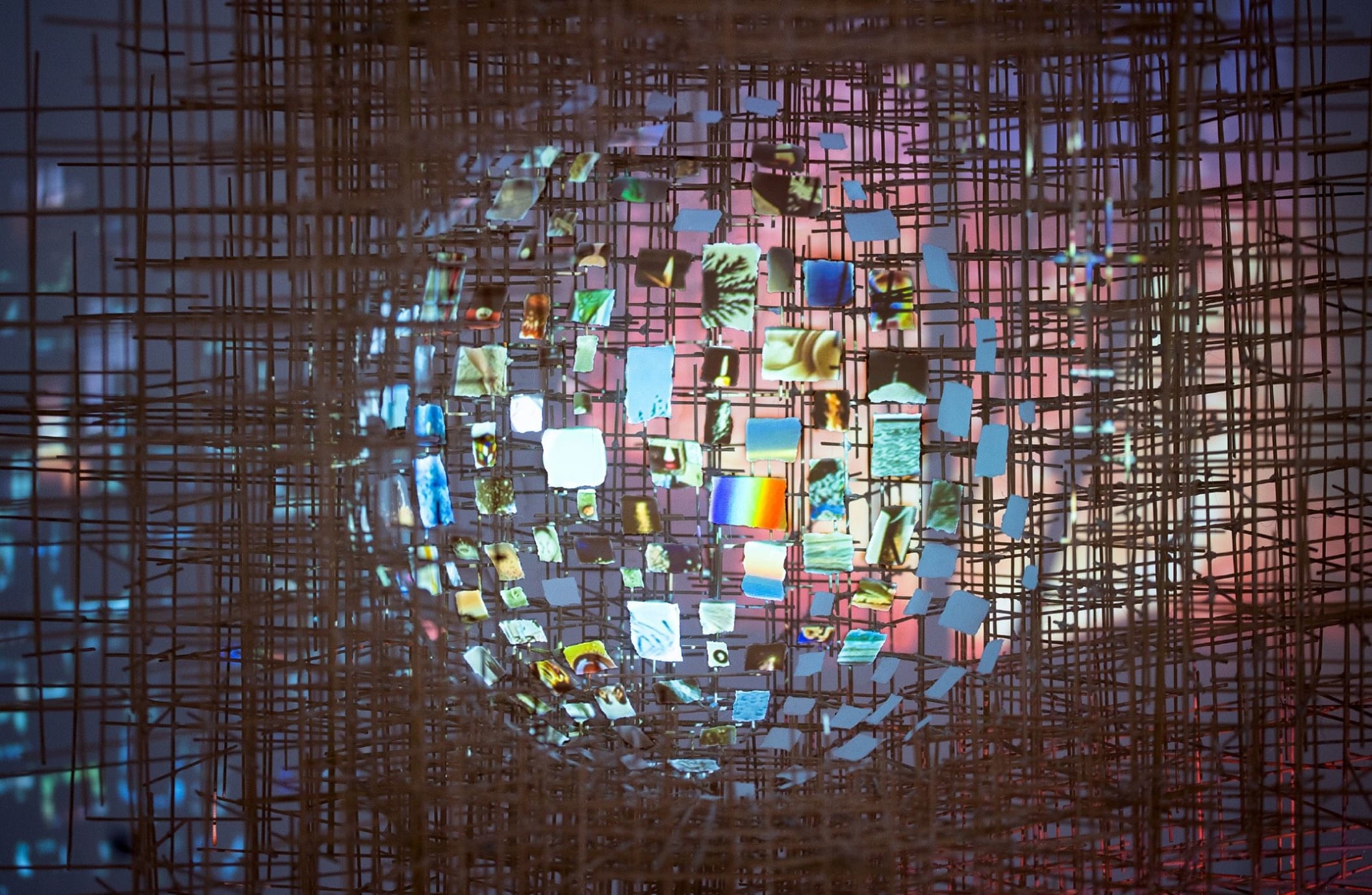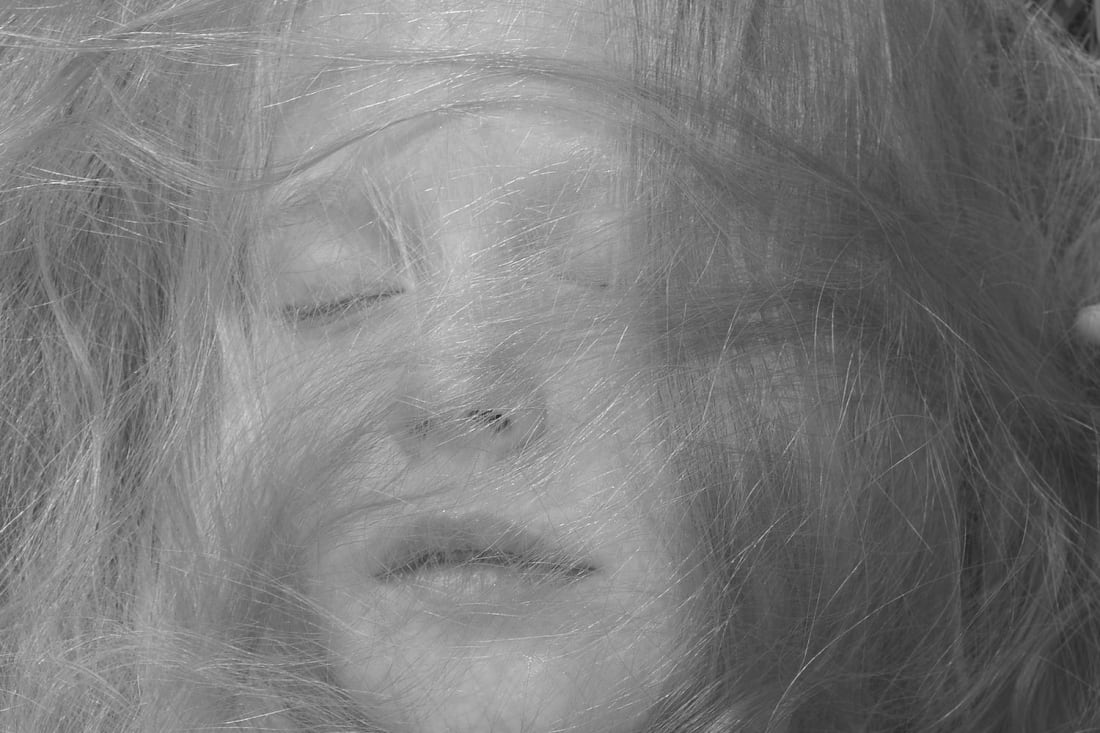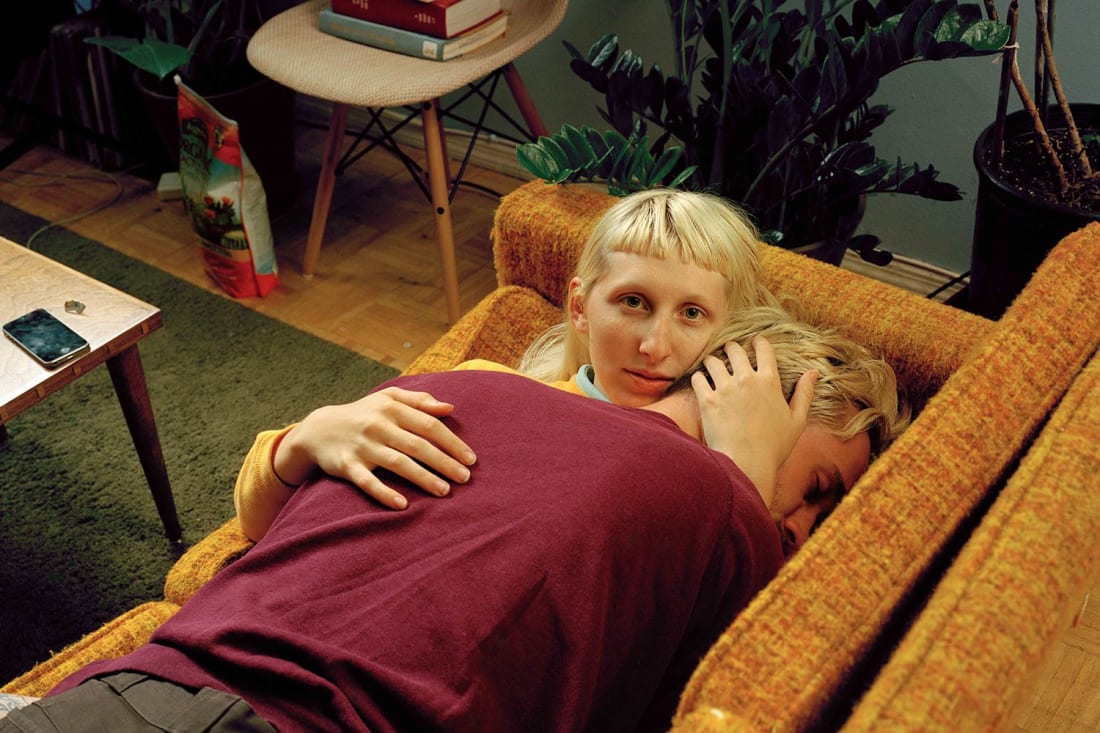Darryl Daley’s dream-like moving image is a spectacular ode to his Jamaican roots
The artist discusses his new solo show, ‘What You See Here / What You Hear Here’, for woo’s fortnightly culture column
The artist discusses his new solo show, ‘What You See Here / What You Hear Here’, for woo’s fortnightly culture column
Welcome to Stop Scrolling, where each fortnight arts and culture writer Gilda Bruno will be bringing you a roundup of carefully curated exhibitions, art fairs and photo books to check out, as well as exclusive conversations with some of today's most exciting emerging artists.
This week, Bruno speaks with London-based graphic designer-turned-artist Darryl Daley about his immersive solo exhibition What You See Here / What You Hear Here: a dreamlike celebration of his Afro-Caribbean heritage, brought to the public through audiovisual works suspended between past, present and future.
For Darryl Daley, being creative has always been about following your instinct and treasuring the beauty which lies in the ordinary. After cutting his teeth as a graphic designer and art director, the South London talent laid the foundations of his multidisciplinary practice as he sought new ways of “channelling” his expansive imagination.
As an avid film lover, the artist spent his teenage years in awe of ground-breaking directors including Spike Lee, John Singleton, Akira Kurosawa and Takeshi Kitano. Today, his list of inspirations counts anyone from Oscar-winning Guillermo del Toro and Paolo Sorrentino to French New Wave pioneer Agnes Varda, instrumental figures in African cinema such as Med Hondo and Ousmane Sembène, Black Audio Film Collective co-founder John Akomfrah, and American cinematographer Arthur Jafa.
Rather than directly influencing Daley’s visual aesthetic, those names “sparked my passion for film as a medium and an art form long before I thought of trying my hand at it”, the artist explains. Of all the films he watched while growing up, Godfrey Reggio’s Koyaanisqatsi left the deepest mark on him. “Imagine a David Attenborough's nature documentary but it is all about humans,” Daley says of the Philip Glass-scored experimental film. “It is footage of people from around the world paired with these beautifully orchestrated sound overlays: one of the most poetic things I have ever seen.”
Known for his strikingly evocative approach to moving image, photography and sound, Daley leverages the multisensory essence of his combined mediums of choice in audiovisual artworks which – taking shape in a liminal, otherworldly dimension – echo the long-lived traditions, affections and tales of his Jamaican heritage. Looking at his ancestors’ home through a second-generation gaze, the artist reinterprets his grandparents’ journey to Britain in surreal video collages celebrating the intricate jigsaw that is his diasporic identity.
To mark the opening of What You See Here / What You Hear Here, Daley’s new solo exhibition and NOW Gallery’s 2023 Young Artist Commission, we speak to him about the “unlimited” possibilities of film, art as a means of processing displacement, and his quest to make work which “transcends the immediate”.

As a graphic designer and art director, you have worked with anyone from Nike to the Victoria & Albert Museum. What prompted you to explore other artistic mediums?
Darryl Daley: Tapping into photography, film and sound granted me a wider palette through which to express my ideas. It all began with Scene + Heard, the London-based collective I co-founded with some of my mates back in 2016, which brought curated nights across cinema and music with a focus on the Black diaspora. Through screening films and documentaries by culturally and historically significant Black directors, Scene + Heard preserved the legacy of eminent African and Afro-Caribbean authors while also engaging the public in DJ line-ups, panel discussions, art exhibitions and club nights. I started working with audiovisual archive material when putting together promotional content for the collective’s events. Even before then, I remember trying to find ways to use my phone as an artistic tool.
One day a friend showed me a photographer’s Instagram – which I didn’t have at the time – suggesting I used the app as my “sketchbook”. I had always loved photography, especially street photography, so looking at my phone as a means of capturing my surroundings felt like going full circle. Soon after, I began to film the mundane moments which would occur to me, be it buses going past or leaves falling on the ground, adding sound or music to them. For a long time, I would work on those sequences without realising what I was doing. Only during covid did I find the space to indulge in this practice intentionally. Today my work consists of archive footage which I play against something else, mostly original videos, in a sort of film collage.
What role does your Afro-Caribbean ancestry play in the shaping of your visual narratives? How does your craft allow you to get closer to your Jamaican roots?
Darryl Daley: Up until my 20s, I would spend every summer holiday in Jamaica. While I haven’t been there for the past ten years, I carry the idea of Jamaica with me everywhere I go. As a British-born person of Afro-Caribbean descent, that is something that was installed into me by my grandparents, and especially by my grandmother. For her, having left home to move to the UK when she was young, the memory of her motherland was what kept her close to it despite the distance. For us second generation, our grandmother’s homes – their customs, language and culture – were Jamaica, their words Africa. The country I visited during my childhood is not the Jamaica of my mind, and that is what my films are ultimately about.
As for the meaning of them, or how I put them together, there isn’t much I can say. It would be like asking someone who is good at kicking a ball how they do it: they don’t know, they just kick it. Drawing on Afro-Surrealism, I immerse viewers in a dreamlike reality made of multiple stories which stand as a reaction to my experience of displacement; or the fact that, while I have an ancestry that comes from Jamaica, I don’t directly come from that place. Instead, I was born and raised here in Britain and my understanding of Jamaica was handed down to me from somebody else. My craft allows me to interpret having “a home away from home” through the lens of my own imagination.

Congratulations on winning the NOW Gallery’s 2023 Young Artist Commission and opening your new solo show ‘What You See Here / What You Hear Here'. How would you describe it in your own words?
Darryl Daley: What I am trying to capture through my filmic work is a moment which lies at the intersection of memory, imagination and the present. I am interested in lensing what happens at the crossing between the three while simultaneously exploring notions of identity, culture and the home. What You See Here / What You Hear Here invites the audience to interact with the works on display with all their senses. The idea is that, if you were to cover your eyes, the artworks would still tell you a story, whereas if you were to cover your ears, the films would speak to you visually.
The exhibition features four audiovisual pieces; ‘Patois’, ‘Xaymaca’, ‘No Ghosts’, and ‘UNU (You & You)’. What do these projects tell us about the vision that drives your creative experimentation? What has developing them unlocked in you?
Darryl Daley: Working on this kind of projects is the real “unlocking”. The end result per se doesn’t necessarily unlock anything; or maybe it does, but I don’t analyse my life through my work. What I am doing allows me to express the creativity I have beyond the two-dimensional limits of graphic design. Film is an unlimited palette of tools through which I get to know different sides of myself. While I don’t like having to “pick” a single work, if I were to choose the piece that best reflects the vision at the heart of the exhibition, it would probably be UNU (You & You). This film traces the conversation between my grandmother and her carer – both Jamaican, yet from different generations – as they reminisce about their respective pasts in the motherland. Each one of the pieces presented in this show is a continuation of the world I have created through it: part of its footage intentionally reappears from film to film, as if they were an extension of its original narrative.
If you could instil one single realisation into the mind of those visiting ‘What You See Here / What You Hear Here’, what would that be?‘What You See Here / What You Hear Here’, what would that be?
Darryl Daley: For me, it is about feeling the work and ensuring the work leaves something within you. It doesn’t matter if you are from the Afro-Caribbean diaspora or not; these films should speak to you regardless of your origins. These are human stories. Considering the world we live in today – where everything is so disposable and quick, where everything is meant to be used, thrown away and replaced with the next thing – I hope the exhibition evokes something in those who come to see it and that when they wake up the next morning, they still remember it.
Darryl Daley’s solo exhibition What You See Here / What You Hear Here is open at NOW Gallery, London, through June 11


Scroll for an extra dose of art and culture news, curated for you by woo
When there's so much to see and experience, it can be hard to choose where to spend your valuable time. Below, Bruno picks a selection of standout shows and culture events to explore in the coming weeks.
European Month of Photography, various locations, Berlin, DE

Hosted at the Amtsalon, one of Berlin's new cultural venues, the European Month of Photography (EMOP) is a yearly event dedicated to the photographic scenes thriving in (and beyond) the German capital. Continuing through March 31, its 10th edition offers the opportunity to attend 100 exhibitions scattered across the centre of Berlin and Potsdam as well as workshops, lectures, guided tours, performances and panel talks.
This year’s theme is TOUCH, and the EMOP sees a blend of communities hailing from Europe and the world gather to explore the varied ways in which one can interact with their surroundings through the photographic medium. Among the highlights of the 2023 iteration are Urgent Present (through March 26), EMOP Berlin’s new format and showcase spotlighting the vision of local photography students; Vanja Bućan’s solo show Birds of Paradise, which dissects women’s role as domestic workers through a feminist lens; and _Cast out of Heaven _a love letter to the people of Iran, lensed by Hashem Sakeri.
Aïda Muluneh: This is where I am, Public Art Fund, New York, US

The hypnotising work of Ethiopian-born, Abidjan-based artist Aïda Muluneh has taken over the streets of New York City, Boston, Chicago and the Ivorian capital Abidjan on the occasion of her new solo exhibition, This is where I am.
Curated by Katerina Stathopoulou, adjunct curator at Public Art Fund (the institution behind the event) and on view through May 21, the show presents 12 of Muluneh’s striking photographs and brings them to the public via over 330 JCDecaux bus shelters across the above destinations.
Informed by the artist’s experience of displacement, her practice consists of a reworking of the multiple historical, cultural and socio-political references which form her identity. Emerging from the skilfully hand-painted backdrops that serve as the photographer’s trademark, and inspired by Tsegaye Gabre-Medhin’s 1974 poem This is where I am, the images on display honour the resilience of the Ethiopian people and their nation.
Art & Commitment: A Focus on the French Scene, part of Art Paris, Paris, FR

Now at its 25th edition, Art Paris is among the leading fairs for modern and contemporary arts in the world. Running at the Grand Palais Éphémère between March 30 and April 2, this year’s event reunites 134 galleries from 25 different countries for a total of more than 900 represented artists.
The first fully sustainably designed art fair, Art Paris features a programme of activities spanning curator talks, solo and group exhibitions and more. Core to this year’s iteration are the themes of “commitment” and “exile”: two notions that are unpacked in the Art & Commitment: A Focus on the French Scene and Exile: Dispossession and Resistance showcases, curated respectively by Marc Donnadieu and Amanda Abi Khalil.
While the former explores the state of the contemporary French art scene through a selection of artists whose work speaks to their devotion to their craft, society and the world; the latter brings together 18 creatives who rely on art as a means of dealing with their experience of exile and migration.
Human Brains: Preserving the Brain, Forum on Neurodegenerative Diseases, exhibition, Prada Rong Zhai, Shanghai, CN

Launching May 31 at Shanghai’s Prada Rong Zhai – the monumental 1918 palazzo which was restored to its prime by the Italian house back in 2017, now serving as a multipurpose venue for the brand’s China-based activations – Preserving the Brain is the fruit of a years-long research study undertaken by the luxury label into the field of neuroscience.
Part of Human Brains, Prada’s multidisciplinary project drawing on the intersections of neurobiology, neurochemistry, psychology, linguistics, philosophy and artificial intelligence, the showcase seeks to facilitate the understanding of brain mechanisms related to neurodegenerative diseases by leveraging the expertise of award-winning institutes and the visual support provided by New York-based studio 2x4.
At once acknowledging the brain’s “intrinsic complexity and irreducible singularity”, the event strives to foster a dialogue on the importance of personalised medicine, raising awareness of the deeply individual factors that contribute to shaping one’s experience of the same condition.
Sarah Sze: Timelapse, solo exhibition, Guggenheim, New York, US

Multidisciplinary artist Sarah Sze breaks the fourth wall in her upcoming solo exhibition at New York’s iconic Guggenheim Museum. Opening on March 31, Sarah Sze: Timelapse will see the Boston-born creative engage the audience in a series of site-specific installations standing for her ability to mould spaces that transcend all ordinary definitions.
Hosted by the institution’s Frank Lloyd Wright building – a landmark of 20th-century architecture and UNESCO World Heritage site – the show will move beyond the museum walls to interact with the public in the open air. Here, Sze will mimic the incessant flow of traffic and passers-by traditionally embracing the building’s exterior through a “flowing river of images”, while a projection of the moon on its facade will mirror the satellite’s cycle over the course of the event.
Organised by Kyung An, associate curator of Asian Art, Timelapse will reflect on the concept of time, memory and collective experience by immersing visitors in a game of contrasting reflections, textures and sounds. In the artist’s words, the showcase is “a contemplation on how we mark time and how time marks us”.



